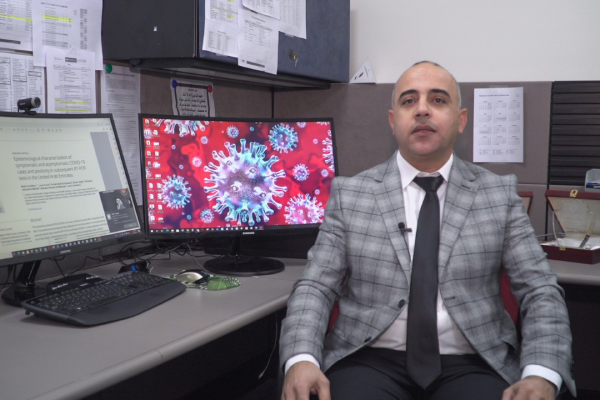Study of First Cohort of Abu Dhabi COVID-19 Patients Reveals High Proportion of Positive Cases Without Symptoms
In any pandemic, it is critical to understand the mode of transmission the infectious agent is using to infect populations as early as possible. Following rigorous epidemiological research, characterization of the infected individuals helps scientists understand which parts of the population are susceptible to infection and what the risk factors are that contribute to disease transmission. Asymptomatic infections (those who carry the virus without showing symptoms) are a major challenge in controlling infectious pandemics.
The first major epidemiological study conducted in the UAE during the COVID-19 pandemic was led by Dr. Rami H. Al-Rifai, assistant professor and epidemiologist at the Institute of Public Health, United Arab Emirates University (UAEU). In collaboration with researchers from Khalifa University and the Abu Dhabi Public Health Centre, Dr. Al-Rifai studied the demographic and medical characteristics of the first batch of COVID-19 patients reported in the Abu Dhabi Emirate. The research group was able to understand the most common symptoms of the disease, to determine how many infected people were asymptomatic (showing no symptoms), and to describe the demographic and medical differences between symptomatic and asymptomatic COVID-19 patients.
The study included the first 791 COVID-19 patients reported in the Abu Dhabi Emirate, 44% of whom showed no symptoms of infection. The study also found out that the two most frequent symptoms were fever (58%) and cough (41%). People over 40 years old and those working in public closed spaces including healthcare settings and aviation and tourism were more likely to develop symptoms of COVID-19. Additionally, the study found that people with at least one chronic medical condition (mainly diabetes or diseases of blood pressure) were more likely to develop symptoms of COVID-19. In fact, when people develop symptoms, it means that there is a fierce war between the virus and the infected person s immune system. Developing symptoms also means that the disease is progressing inside the body and an intervention is needed to control the spread of the virus to avoid further cell and organ destruction. Nevertheless, people who contracted the virus without showing symptoms would serve as silent transmitters passing the virus to the other healthy populations. Silent transmitters pose a major challenge in controlling the ongoing COVID-19 pandemic.
About a third (35%) of patients without symptoms were still testing positive after an average of 8 days after their initial diagnosis, while at least twice this proportion of symptomatic patients did so. This finding was for the whole patient group and not influenced by the age and underlying chronic medical conditions such as diabetes and hypertension.
 This is the first study in the UAE to characterize COVID-19 positive cases by symptoms and sheds light on the strength of association between sociodemographic characteristics and chronic medical conditions with symptomatic state of the COVID-19 case. The high proportion of people diagnosed with COVID-19 cases while asymptomatic (while they are still in the pre-symptomatic phase) is due to the mass tracing and testing activities implemented by the health authorities in the UAE. Dr. Al-Rifai said It is worth highlighting that UAE is one of the top countries in the world in terms of the number of COVID-19 screening tests. By February 18, 2021, in a country with a total population of around 10 million people, nearly 30 million tests had been performed.
This is the first study in the UAE to characterize COVID-19 positive cases by symptoms and sheds light on the strength of association between sociodemographic characteristics and chronic medical conditions with symptomatic state of the COVID-19 case. The high proportion of people diagnosed with COVID-19 cases while asymptomatic (while they are still in the pre-symptomatic phase) is due to the mass tracing and testing activities implemented by the health authorities in the UAE. Dr. Al-Rifai said It is worth highlighting that UAE is one of the top countries in the world in terms of the number of COVID-19 screening tests. By February 18, 2021, in a country with a total population of around 10 million people, nearly 30 million tests had been performed.
This pandemic calls for extraordinary measures to defeat the virus. It is vital to implement additional strategies to prevent further transmission, including quarantine of asymptomatic cases along with prevention measures and raising awareness of populations working in high-risk settings. Following public health preventive measures including avoiding crowded places, wearing a mask, and social distancing in public places, particularly elder people and those who are suffering from chronic medical conditions, would have a vital role in avoiding contracting the virus or transmitting it to others, particularly when we are silent transmitters (asymptomatic carriers).
Indeed, such epidemiological studies are of paramount importance to inform health policymakers and guiding public health interventions to control the pandemic as early as possible. These steps will in turn, allow people to go back to normal life and boost the economy of the country.
The full study has been recently published as a peer-reviewed scientific paper in PloS One journal, one of the top 10% international journals. The following link is to access the fully published study: Epidemiological characterization of symptomatic and asymptomatic COVID-19 cases and positivity in subsequent RT-PCR tests in the United Arab Emirates (plos.org)
Dr. Rami H. Al-Rifai, is an Assistant Professor and Epidemiologist at the Institute of Public Health, College of Medicine and Health Sciences, UAE University. Dr. Al-Rifai, gained a PhD degree in Epidemiology from the Tokyo Medical and Dental University in Japan in 2014. He has also been trained in the United States, Japan, Thailand, and Malaysia through joining several training courses related to the epidemiology of infectious diseases. So far, he has produced over 34 scientific papers published in top-ranked international peer-reviewed journals.
Dr. Al-Rifai, joined the UAE University recently in 2017. Since then, he has designed and executed several epidemiological studies investigating various types of infectious and non-infectious diseases among different populations in the UAE. Recently, Dr. Al-Rifai was awarded the Excellence Award in Scholarship from the College of Medicine and Health Sciences at the UAE University.
Do you find this content helpful?
عفوا
لايوجد محتوى عربي لهذه الصفحة
عفوا
يوجد مشكلة في الصفحة التي تحاول الوصول إليها

